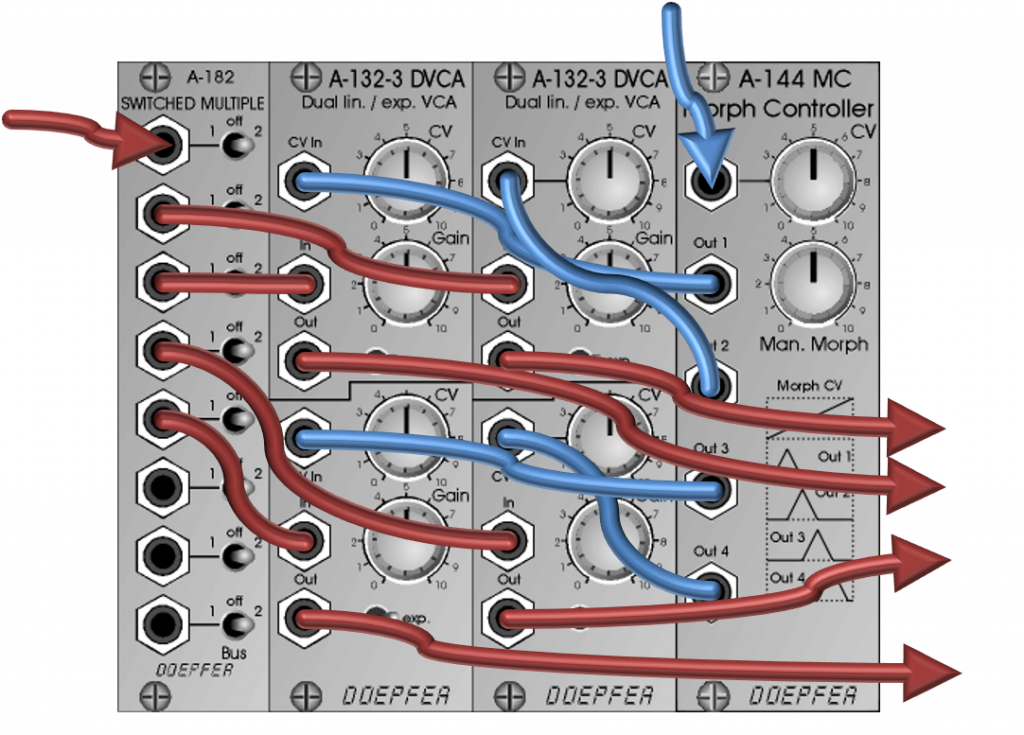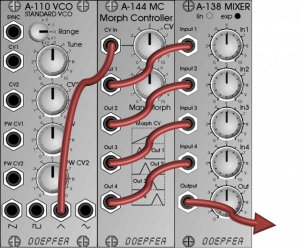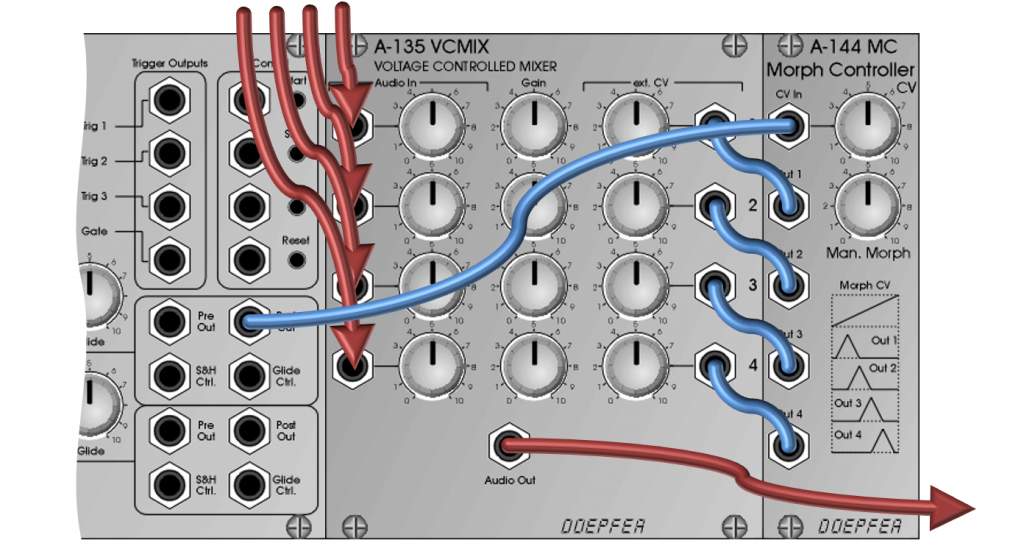The module is no longer in production.
The A-144 Morphing Controller generates control voltages that are used, for example, to regulate four linear VCAs of a voltage-controlled mixer in such a way that the four input signals of the mixer are morphed one after the other. The A-135-1 or A-135-2 Voltage Controlled Mixer and the A-135-4 Voltage Controlled Performance Mixer are suitable for this, but also multiple VCAs with sum output like the A-130-8 or the A-132-8 (here only the linear VCAs).
The A-144 produces four overlapping triangular signals one after the other with a constantly increasing input voltage – as soon as the first triangle falls again, the second triangle starts with a rising edge, the sum of the output voltages from the A-144 is always constant – except at the beginning and at the end of the input control voltage. The first signal (controlled by “Out 1”) is simply faded in and the fourth signal (controlled by “Out 4”) is faded out. Together with the mixer’s linear VCAs, this results in a “seamless” crossfade of the mixer’s input signals.
Incidentally, the relationship between the input voltage and the four output voltages is very nicely printed on the front panel of the module.
We’ll see below that morphing isn’t the only interesting use of the A-144 Morphing Controller.
User interface
Inputs:
CTRL-A144-INOutputs:
CTRL-A144-OUTControls:
CTRL-A144-SWPossible uses
Morphing
The principle of the morphing controller is simple: Depending on the “Man. Morph” controller or a control voltage, the four outputs generate rising and then falling control voltages. First the voltage at “Out 1” rises and then falls back to 0 V. During the falling edge, the voltage at “Out 2” increases – it reaches its maximum when “Out 1” has reached 0 V.
The remaining outputs continue in the same way until all four outputs are at 0 V again at the end. This allows four linear VCAs to be controlled so that the first input signal is mixed in first, then fades over to the second audio signal, to the third and finally to the fourth, which fades out again at the end. The A-135-1 VC Mixer has 4 such VCAs, a mixer, attenuator, etc., which makes things very convenient – but with 18 HP, unfortunately, uses up much space in the rack. The controls on the new A-135-2 are a bit more “crowded”; you have to do without the four input attenuators, but you only need 8 HP of space for this.
“Material” for morphing can of course be four fundamentally different audio sources, e.g. four different synthesizer voices, but also the outputs of a VCO for crossfading the waveforms, outputs of multimode filters such as the A-106-6 or also filters with several outputs for the edge steepness like the A-108 6/12/24/48dB lowpass filter or the A-123-2 6/12/18/24dB highpass filter for voltage controlled slope.
Panning / quadraphony
Instead of four input signals, panning for a quadraphonic setup is also conceivable when using four linear VCAs: an audio signal is sent via a distributor to all 4 VCAs that supply four loudspeakers. Disadvantage: Only 2 speakers can be controlled at the same time (the signal is never “in the middle”), and there is no mix between the last and the first speaker. A setup with, for example, the A-134-2 Dual VC Crossfader makes more sense in this case.

The Morph Controller as “overtone generator”

If you use the triangle, sine or sawtooth wave of a VCO as the control voltage, you get an interesting “overtone generator” that produces triangle waves (or variants thereof).
If you use an A-111-1 VCO with its rising sawtooth waveform as the A-144’s control signal, you get a surprisingly complex waveform from the mixture of the four output signals:

Sound examples
Morphing
The A-144 is controlled by an AD generator (loop mode) of an A-143-1 Complex Envelope Generator. The outputs of the A-144 control the volumes of an A-135-2 VC mixer, into which the audio signals of an A-117 Digital Noise, A-110-6 Trapezoid Quadrature Thru Zero VCOs, A-118 Noise Generators (“Colored” Out) and an A-143-9 VC Quadrature LFOs are routed. The A-110-6 and the A-143-9 are frequency modulated by another A-143-9.
Sound example – morphing of filter outputs
Three A-111-1 oscillators (sawtooth, one VCO is transposed down an octave) are controlled by an A-155 sequencer. The sequencer’s trigger output also clocks an A-148 Sample & Hold (with noise as the input signal) that controls the A-144. The four input signals of the A-135-2 VC Mixer are the four filter outputs of an A-121-2 multimode filter. This randomly selects one filter output or the mix of one filter output with another for each sequencer step.
Control by a sequencer
The morphing does not necessarily have to be just a soft transition “A-B-C-D”, but can also be controlled in leaps and bounds. An A-155 sequencer, for example, can supply the control voltage here.

This time, the A-144 is controlled by an A-155 sequencer. The outputs of the A-144 control the volumes of an A-135-2 VC mixer, into which the audio signals of an A-117 Digital Noise, A-110-6 Trapezoid Quadrature Thru Zero VCOs, A-118 Noise Generators (“Colored” Out) and an A-143-9 VC Quadrature LFOs are routed. The A-110-6 and the A-143-9 are frequency modulated by another A-143-9.
Alternatives
There is currently no real replacement for the module, which is unfortunately no longer available. According to Doepfer, however, an extended successor module “A-144-4” is already being planned. I will report and compare as soon as it is available!
Technical specifications
| Width | 8 HP |
| Depth | 40 mm |
| Power requirements | 30 mA (+12V) / -30 mA (-12V) |
